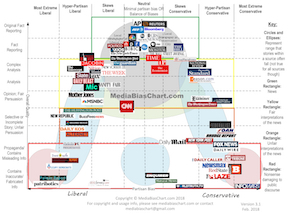 A friend of mine just questioned me on Facebook, “(With) the increase in access to media/information … are people more adept at separating fact from fiction or are they more willing to let others make that decision for them?”
A friend of mine just questioned me on Facebook, “(With) the increase in access to media/information … are people more adept at separating fact from fiction or are they more willing to let others make that decision for them?”
I quickly made a snide reference to recent elector events as evidence, but continued by blaming education. There is so much about the ways that teachers must teach that actually discourages students from critically questioning the information that they encounter. We (educators) teach them to learn and believe what it is that we teach and not to question what they have learned. Teachers are forced into this mode of instruction because schools have become a one-right-answer world. It is because of high-stakes testing and teachers are responsible for their students knowing those one-right-answers.
But what if critical evaluation of the information we encounter really was a core part of what we teach. Here are some ways that teachers might encourage their students to develop critical habits.
- Research the author(s) of your textbook and start the year introducing students to what you’ve learned. Explain how the author’s background gives them the authority to write such a textbook.
- Tell students that not everything in the textbook is true. Explain that part of their job this year is to find its inaccuracies and support their finds.
- Use as much content from the Internet as you can. As you present the content, explain the process you used to finding it and the criteria you used to validate the information.
- When discussing students’ work or their answers to questions, get in the habit of asking, “How do you know that’s true?” Encourage students to have supporting evidence for their answers and the ideas that they share.
- Encourage students to ask you, “How do you know that’s true Mr. ######?” Be ready to answer with supporting evidence. If you don’t have the supporting evidence, ask you’re students to give you a day to research it.
- When you get it wrong, apologize and describe to you students what you learned in the process of getting it wrong. Make use of all wrong answers.
- Talk about your own interests and the research that you conduct to learn more about your interest. Practice contemporary literacy in front of your students
- When you encounter false information or a manipulative message, bring it into your classroom and provide the evidence that proves that it is incorrect. Ask students what they think someone might have to gain by spreading false or misleading messages.
Tell your students that the world as we know is,
Is not the same world the we knew.
What more, it’s not the same world that we will know.
They (your students) are going to be the explorers and discoverers of that world.

Some students, now more than ever, are relying on “googling” for the right answers. As a result, they often miss the big picture, the overarching concept of what it is that they are learning. I know technology can be a great tool for education. But it is a double-edged sword that can also hurt in the full understanding of the concept. How do you teach and train students to think this way?
As a current student teacher pursuing a Master’s degree in Secondary Education, I really appreciated your post about fostering critical evaluation in the classroom. Your eight practices align closely to what I have been learning in my Social Studies Methods and Literacy courses this semester. We have practiced conducting a “Think-Aloud” alongside students to pull back the curtain around our teacher thinking process when evaluating a historical source. Do you have examples of how teachers used critical evaluation in their classes, especially around current political topics? On your 7th point, do you think talking about your own interests and research could be problematic if students take that as a representation of your teaching? For example, I’m interested in LGBTQ rights, but that is a controversial topic to bring up in the classroom. How can teachers strike a balance of sharing personal interests while keeping the focus on academics? Thank you for providing some insight and I would love to learn more!
I appreciated this read. You presented some truly valid points in regards to promoting literacy not only in school but ways it can be used at home as well. Literacy strategies are helpful and be used across the content curriculum. Your eight practices can be beneficial to increasing student vocabulary as well. The practice of asking students to cite their evidence is helpful for accountability talks and understanding topics in context. The idea of also being human and apologizing for when things are done wrong is remarkable. I believe this is helpful in building a relationship and creating an atmosphere where individuals feel that it is a safe space to learn. The practices are helpful as it also embodies the idea of also sharing your own interest with students and technology to assist in the process. It was truly a great read and a way to become more reflective in my instruction.